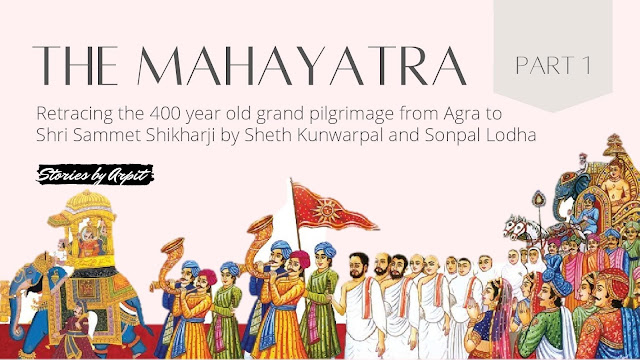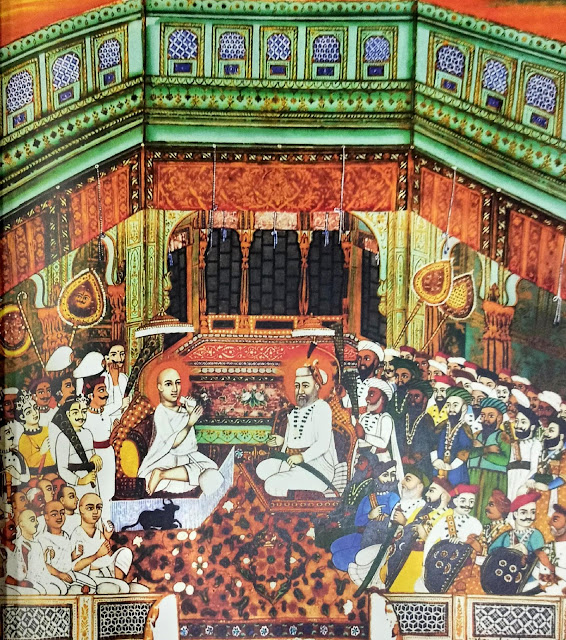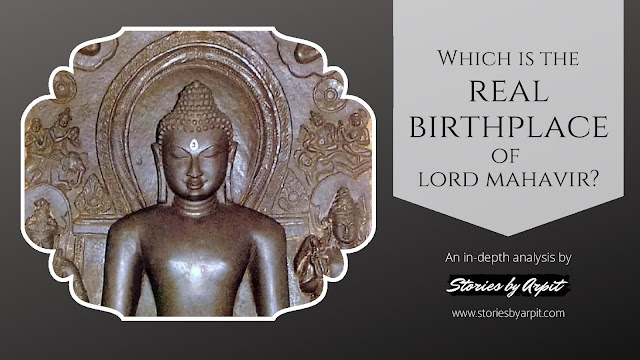The Mahayatra - Part 1
 |
| The Mahayatra |
Introduction
In the early years of 17th Century, most parts of the Indian subcontinent were under the rule of Mughal emperor Jahangir. Jains had gained significant access and built up cordial relations in the Mughal court following Gujarat's absorption into the Mughal Empire in the 1570’s. Jahangir’s father and predecessor, Emperor Akbar met Acharya Shri Hiravijaysuri in 1582 after hearing about the monk’s legendary wisdom and religious devotion and bestowed the Acharya with the title of “Jagad-guru” (Preceptor of the World). Thereafter several monks like Acharya Jinchandrasuri, Acharya Jinsinhsuri, Ganivarya Bhanuchandra, Acharya Vijaysensuri and Acharya Siddhichandrasuri graced the Mughal courts of Akbar and Jahangir. They championed policies that lessened violence against animals, banished Jiziya (religious tax) and gained ownership of Jain pilgrimage centres. |
| Jain monks at the court of Mughal Emperor Akbar |
During this era, in 1613 AD (Vikram Samvat 1669), two brothers – Kunwarpal & Sonpal Lodha from Arggalpur (Agra) initiated a grand Sangh-yatra (pilgrimage with the four-fold congregation[1]) to Shikharji Tirth – the Nirvan Bhumi (place of liberation) of 20 Tirthankars. Although there have been many grand Sangh Yatra’s in the past, this remains one of the most enigmatic travel experiences as it was undertaken in the Gangetic belt of Northern India, a less frequented region by Jain pilgrims (in comparison to Western India) despite a large number of Kalyanak Bhumis[2] in the region.
The entire experience of the Sangh-yatra covering more than 55 places from Agra to Shikharji was beautifully recorded and narrated in two different ballads by Jain sadhus (monks) who were a part of this grand Sangh yatra. The first ballad is named “Sammetshikhar Raas” (composed in 483 verses) by Shri Jaskirti of Anchalgacch[3] and another one is known as “Sammetshikhar Tirthmala” (composed in 91 verses) by Panyas Shri Jayvijayji of the Tapagacch[4]. Shri Agarchand and Shri Bhanwarlal Nahata translated the Sammetshikhar Raas to Hindi[5] and Acharya Dharmasuri published the Sammetshikhar Tirthmala in his book “Prachin Tirthmala Sangraha”. Based on these two ballads, the entire Sangh Yatra has been retraced and this research has been constructed.
The Sanghpatis
Kunwarpal and Sonpal were sons of Sheth Rishabhdas Lodha of the Oswal clan. Their family was wealthy and well known among the Jain community. Both the brothers served as ministers/ estate managers[6] in the court of the Emperor Jahangir. Kunwarpal had three sons named Sanghraj, Durgadas and Dharmpal while Sonpal also had three sons named Roopchand, Chaturbhuj and Tulsidas.
 |
| Mughal Emperor Jahangir (Credit: Wikimedia Commons) |
During their lifetime, they installed idols at Shatrunjay, Mirzapur, Lucknow, Patna, Agra etc. and organised various Sangh yatras to Shatrunjay, Girnar and Abu Tirth’s apart from Sammet Shikhar. In 1628 AD, (Vikram Samvat 1684) they installed 450 Jain idols in the temples of Agra under the nishra (presence and guidance) of Acharya Kalyansagarji Maharaj of Anchalgacch. The pilgrims of the Sammetshikhar Sangh awarded them with the title of ‘Bhoopal’.[7] [8]
The conception of Sangh-yatra & Invitations
Twelve years after both the brothers organized a sangh-yatra to Shatrunjay and installed various images in 1600 AD, Sonpal suggested Kunwarpal to organize a pilgrimage to Shri Sammet Shikhar Tirth. Kunwarpal, overjoyed with the thought, agreed readily. The brother’s summoned various Jyotishi’s (astrologers) to fix a pious date to commence the sangh-yatra. The jyotishi’s decided on the fifth day of Magh Krishna month of Vikram Samvat 1669 corresponding to Friday, 25th January 1613[9] as the auspicious date to commence the pilgrimage.
Kunwarpal prepared a beautiful Vinantipatra[10] (painted scroll) from the best artisans of Agra and sent his eldest son Sanghraj to Rajnagar (Ahmedabad) to invite the Gacchadhipati (head of the monastic order) of the Anchalgacch, Acharya Shri Dharmamurtisuri who had presided over their earlier sangh-yatra to Shatrunjay. After reaching Ahmedabad, Sanghraj handed over the Vinantipatra and requested Gacchadhipati Shri Dharmamurtisuri to preside over the Sangh yatra to Sammet Shikharji. However, due to Gacchadhipati’s advancing age and considering the long vihar yatra (foot travel) to Shikharji, he politely declined the invitation. Sanghraj respectfully accepted Gacchadhipati’s decision and after engaging in good deeds (Prabhavana’s[11]) at various stops, he reached Fatehpur Sikri where the local Sangh (congregation) had prepared a grand welcome for him.
 |
| Sanghraj requesting Acharya Dharmamurtisuri for presiding over the Sangh-yatra |
To obtain the Shahi Farman (royal mandate/ decree), both Kunwarpal and Sonpal went to Emperor Jahangir’s court with various gifts. The Grand Diwan (treasurer) Mirza Ghiyas Beg praised both the brothers and gave their recommendation to Emperor Jahangir. The Emperor announced that he knew the Oswal brothers very well as they “glorified personalities of Agra” and served as “Kothipals” (estate managers) of Mughal empire. Emperor Jahangir added that he was very happy with the brothers and they could ask for anything they wanted. The brothers explained their vision of sangh-yatra, which impressed Emperor Jahangir. The Emperor praised the brothers and immediately issued a Shahi Farman under the seal of the Mughal empire granting permission and safe passage for the Sangh-yatra along with Siropav (attire) and nishan (noble mark).
 |
| Kunwarpal and Sonpal at Jahangir's court to obtain the Shahi Farman |
With a small procession and amidst fanfare both the brothers along with various dignitaries reached their home from where they issued invitations to various Shwetambar and Digambar Jain Sanghs across 70 cities in the undivided Indian subcontinent. Some of the major locations where the invitations were sent were –
- Present state of Gujarat: Ahmedabad, Patan, Khambhat, Surat, Gandhar, Bharuch, Halvad, Morbi, Tharad, Radhanpur, Siddhpur etc.
- Present state of Rajasthan - Sanchor, Bhinmal, Jalore, Jodhpur, Nagaur, Phalodhi, Jaisalmer, Tijara, Ajmer, Sanganer, Pali, Sadri, Bikaner, Sirohi, Barmer etc.
- Present Pakistan – Multan, Lahore etc.
- Present state of Uttar Pradesh - Delhi, Sikandara, Sikandarabad, Pirojpur, Fatehpur, Babarpur etc.
- Present state of Madhya Pradesh – Ujjain, Mandavgadh, Ratlam, Gwalior, Burhanpur etc.
The members of the Sangh-Yatra
The description of the members of the Sangh-yatra in the Sammetshikhar Raas shows the religious tolerance practiced by brothers Kunwarpal- Sonpal as well as Jains in the past. The sangh-yatra included 75 Shwetambar sadhu-sadhvis (monks-nuns) and 46 Digambar sadhus apart from 300 Brahmins (Vedic priestly class), Jogis (Vedic hermits who practiced higher forms of Yoga and meditation), Sanyasis (Vedic religious mendicants), Dervishes (Sufi saints), Bhojaks (a clan of devotional singers), Charans (a clan of bards) and Gandharvs (a clan of devotional dancers and performers). The entourage included 500 Subhats (infantry) to protect the sangh along with 21 carts, which provided and donated to the needy en-route the entire stretch of journey.
Eminent personalities like Chaturbhuj Sah, Dhanpal, Sundardas, Shurdas, Shivdas, Jethmal, Padamsee, Chammasah, Chaangraj, Chaudhury Dargu, Sah Vaccha Hira, Sah Bhoja, Rajpal, Sundardas, Sah Rekha, Sah Shrivacch, Jatmal, Rushabhdas, Vardhman, Pachu Sachu, Kataru, Sah Tarachand, Mehta Vardhan, Sukha Sicha, Surdas Paisari Narsinh, Sohilla, Meghraj, Kalyan, Kalu, Thansing, Tarachand, Muldas, Hansa, Lilapati etc. were also a part of the sangh-yatra.
 |
| Kunwarpal and Sonpal Lodha returning from Emperor Jahangir's court. |
To be continued...FOR PART 2: CLICK HERE
Part 2: The journey of Sangh-yatra from Agra to Sauripur, Kaushambi, Mahua, Prayag, Banaras, Bhadaini, Chandrapuri, Sinhapuri etc along with past and present analysis.
Part 3: The journey of Sangh-yatra to Patna, Bihar Sharif, Pawapuri, Nawada to Sammet Shikharji etc along with past and present analysis..
Part 4: The return journey of Sangh-yatra to Agra, via Rajgiri, Ayodhya, Ratnapuri and various other tirths along with past and present analysis..
References
[1] The Jain Congregation is known as the Jain Sangh which is composed of the following four groups: Sadhus (Monks), Sadhvis (Nuns), Shravaks (Male householders) and Shravikas (Female householders)
[2] Kalyanak Bhumi’s are places where any of the five Kalyanaks, i.e. chief auspicious events – Chyavan (Conception), Janma (Birth), Diksha (Initiation), Kevalgyan (Enlightenment) and Nirvana(liberation) took place in relation to 24 Tirthankars. These are considered places of pilgrimage by Jains
[3] Anchalgacch, also known as Achalgacch or Vidhi Paksha Gacch is a monastic order of the Shwetambar sect of Jainism. It was installed by Acharya Arya Rakshitsuri in 1113 AD at Pavagadh.
[4] Tapagacch is a monastic order of the Shwetambar sect of Jainism. The name of the monastic order changed from Nirgranth Gacch to Kotik Gacch to Chandra Gacch to Vanvasi Gacch to Vad Gacch and finally to Tapa Gacch in 1228 AD.
[5] Jaskirti krut Sammetshikhar Raas ka Saar, Agarchand & Bhanwarlal Nahata (Arya Kalyan Gautam Smruti Granth)
[6] Different Prashasti’s (euologistic inscriptions) show that they served as Amatyu/ Kothipal/Sealdar in Jahangir’s court.
[7] Transformations in Indian History, Pratima Asthana, Saiyid Zaheer Husain Jafri, Pg. 295
[8] http://oswals.net/gotras/lodha
[9] Drik Panchang
[10] A Vinantipatra was an elaborate hand painted scroll addressed to eminent Jain monks. By sending such scrolls, prominent Shravaks requested the monks to spend the upcoming monsoon season (chaumasa) in their town or as an invitation for events like Pratishthas and Sangh Yatras. The scrolls contained paintings of local city, prominent citizens, cultural activities etc.
[11] Prabhavana means promulgation of Jain doctrine and covers anything done to spread the Jain faith and increase the consideration in which it is held.










Comments
Post a Comment